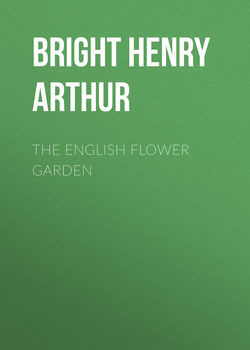The English Flower Garden

Реклама. ООО «ЛитРес», ИНН: 7719571260.
Оглавление
Bright Henry Arthur. The English Flower Garden
PREFACE
THE ENGLISH FLOWER GARDEN
NOTES
NOTE I
NOTE II
NOTE III
NOTE IV
NOTE V
Отрывок из книги
As spring comes on, the fancy of any man who cares about a garden, “lightly turns to thoughts” of flowers and the gardens where they grow. Never, perhaps, was the art of gardening so popular, – I wish we could say so intelligent, – as at present. The stately homes of England, the villas that line the roads of suburban districts, the cottages clustering round a village green, often even a back yard or window-sill in the heart of some manufacturing town, all testify in their different ways to the desire of having an adornment of flowers. Indeed this desire, as Bacon long ago pointed out, in his famous and often-quoted essay, is as old as man himself; or, if any one prefer to trace back the instinct, not to the Garden of Eden, but to the habits of a bird, he may be reminded of the Gardener Bower-bird (Amblyornis inornata) of New Guinea, who, making a bower for the pleasure of his mate, will decorate the front of it with flowers carefully stuck into the sod.1
Nothing more strikingly shows the interest that is now taken in gardening than the number of books that are published on the subject. Besides those that deal less with the craft of the gardener than with the flowers themselves, we have Manuals of gardening, with their annual and monthly calendars of gardening operations, their practical advice and technical knowledge. Then there are the almost countless catalogues of the nurserymen and seedsmen, which often add excellent, and sometimes coloured, engravings, and always supply much useful information. Moreover, in addition to the gardening articles that appear in the Field and elsewhere, there are no less than six weekly newspapers, and five monthly periodicals, all devoted to gardening. Lastly, from time to time some publication comes out in parts, as a monograph on some particular species or group of plants, which, with its beautifully-painted illustrations, will one day take its place among other magnificent folios in the botanical libraries of the world.
.....
And now the period of the so-called “landscape gardeners” began, though in reality their business was rather with the grounds than with the garden proper.
Of these Kent was the first of eminence. Their idea was to destroy all the old-fashioned formalities, at the sacrifice of a certain stateliness which the style possessed, and to bring the scenery of an English park up to the house itself. But they were constantly haunted and harassed by the word “picturesque.” Was Nature more picturesque when closely followed or carefully improved? Was it the duty of the landscape gardener to arrange his clumps and belts of trees in the way in which they would look best in a picture? This was evidently Kent’s idea, and Daines Barrington, speaking of him, says it was reserved for him “to realize these beautiful descriptions [in the Faery Queen], for which he was peculiarly adapted by being a painter, as the true test of perfection in a modern garden is that a landscape painter would choose it as a composition.” Kent’s great work seems to have been the carrying out of the alterations at Stowe, on which Bridgeman had been originally employed, and much of the beauty of those famous grounds – which, however, were at least as artificial as natural – was owing to his taste. The two peculiarities now generally associated with his name are the planting of dead trees to look picturesque, and the constant use of Ha-ha’s (or sunk fences), which he is often said to have originated, though, as matter of fact, Batty Langley also (and I think previously) advocates their adoption.3 “Capability Brown” was perhaps the next most noted landscape gardener. His idea was always to improve nature, and he was particularly strong in artificial lakes and canals, with rather formal clumps of trees. He had many disciples, and it seemed as if half the fine places in England were to be reformed on the new principles.
.....